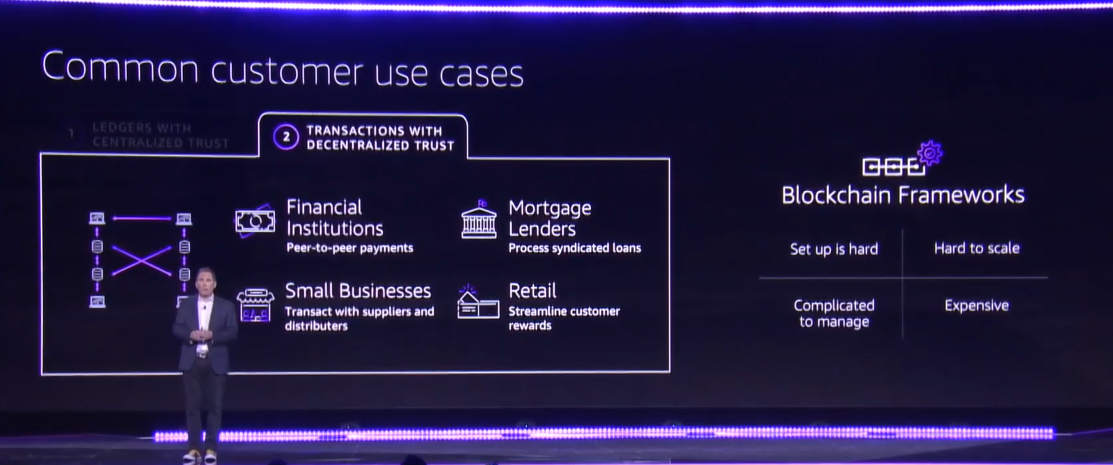AWS goes blockchain: The cloud giant announces two distributed ledger services


Amazon Web Services (AWS) CEO Andy Jassy said his company has spent a decent amount of time understanding why customers want blockchain rather than just a database, denying during his AWS re:Invent keynote that AWS was avoiding heading down the distributed ledger path.
See from re:Invent 2017: AWS not buying into the blockchain hype
"Even though we have a lot of customers that run blockchain on top of us ... we just hadn't seen that many blockchain examples that couldn't just be solved by a database," Jassy said.
"The culture inside AWS is that we don't just build things... we understand what problem you want to solve and we then solve it for you."
Also: Executive's guide to implementing blockchain technology | Blockchain and business: Looking beyond the hype | The blockchain explained for non-engineers
On Wednesday, Jassy revealed that AWS is in fact launching two ledger-related services, both centralised and decentralised, saying his company had a significant number of customers who wanted ledgers with centralised trust, but also transactions with decentralised trust.
The first, Amazon Quantum Ledger Database (QLDB), is a fully-managed ledger database with a central trusted authority.
It's immutable, cryptographically verifiable, transparent, fast -- allowing for the execution of double the amount of transactions as standard, it's scalable, and easy to use, Jassy explained.
The second ledger-related service is the Amazon Managed Blockchain, which allows users to create and manage scalable blockchain networks using both Ethereum or HyperLedger.
Jassy said it scales to support thousands of applications running millions of transactions, and users can manage their blockchain networks using simple API calls.
Data from the Amazon Managed Blockchain can also be moved into the Amazon QLDB for analysis, Jassy explained.
"In retrospect, it was pretty obvious," the CEO said.
Also: Cloud wars 2018: 6 things we learned
Disclosure: Asha Barbaschow travelled to AWS re:Invent as a guest of AWS
Cloud services: 24 lesser-known web services your business needs to try
Primers:
- What is AI? Everything you need to know about Artificial Intelligence
- What is Machine learning?
- What is Deep learning?
- Artificial general intelligence?
- The AI, machine learning, and data science conundrum
Previous and related coverage:
What a hybrid cloud is in the 'multi-cloud era,' and why you may already have one
Now that the services used by an enterprise and provided to its customers may be hosted on servers in the public cloud or on-premises, maybe "hybrid cloud" isn't an architecture any more. While that may the case, that's not stopping some in the digital transformation business from proclaiming it a way of work unto itself.
Cloud computing: Here comes a major tipping point
Application spending has moved to the cloud fastest, but other areas of IT spending are catching up.
Related stories:
- AWS re:Invent 2018: A guide for tech and business pros (free PDF) TechRepublic
- What's the best cloud storage for you?
- https://www.zdnet.com/article/whats-the-best-cloud-storage-for-you/Top cloud providers 2018: How AWS, Microsoft, Google
- https://www.zdnet.com/article/cloud-providers-ranking-2018-how-aws-microsoft-google-cloud-platform-ibm-cloud-oracle-alibaba-stack/Everything you need to know about the cloud, explained
- XaaS: Why 'everything' is now a service
- Infographic: Why companies are switching to Everything as a Service
- Free PDF download: The Future of Everything as a Service
- SaaS, PaaS, and IaaS: Understand the differences
- Cloud computing: How to make the move without losing control
- Amazon cloud lead shrinks as Microsoft Azure growth explodes TechRepublic